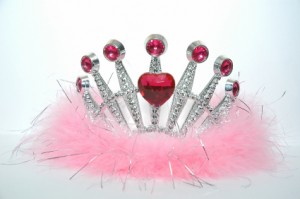 Have you ever tried to convince someone that they don’t like something they clearly like, because it doesn’t serve you very well that they like it?
Have you ever tried to convince someone that they don’t like something they clearly like, because it doesn’t serve you very well that they like it?I catch myself worrying that I’m doing this with clients sometimes. Not when I’m trying to sell them to hire me (because I wouldn’t be trying to sell them if I didn’t genuinely believe they needed something I could give them). It’s usually once they’ve already hired me. They have a direction or theme or vision that I don’t like. But it’s often hard to figure out if the objection is about me, or about what I feel will best serve them.
The best way to sort through it is the princess test.
What Trumps What?
So, the princess test.
It involves a 4-year-old (my daughter), a corporate empire (Disney), and a woman (me) who has a real problem with stories where girls are tricked, drugged, locked away, enchanted, or otherwise screwed up, and men have to come to the rescue over and over again.
My daughter doesn’t see it this way. She just loves pretty dresses and wands and shoes and tiaras (“a tiara, mommy, please!”) and necklaces and bracelets and play-acting.
I know that she is only doing what generations of little girls have done in a culture where Disney has prime emotional real estate. But still, her princess obsession doesn’t serve me very well. After all, I vowed to teach my daughter to be independent. To figure things out for herself. To question frequently. And to never, never, EVER rely on a man to save you.
I won’t let her watch Disney princess movies, I thought. We’ll only get books out of the library about women pioneers. We’ll avoid baby dolls and stereotypical girl toys and clothes.
Yeah, none of that happened.
I spent the better part of last October talking her out of being a princess for Halloween. Finally, I convinced her to be a butterfly. I made her very pink butterfly costume, which had wings, a sparkly vest, and a tutu. It was a version of a princess I could handle.
She was so happy dancing around in her tutu, all sparkles and tulle. “I look just like a princess, mommy!”
It was time to melt. “You do,” I said, sighing like a woman defeated by adorableness.
It’s taken me this last year to realize that I can teach her everything I want to teach her about independence and responsibility and smartness while she is wearing a Snow White costume.
I still insist on coming up with new versions of nearly every single princess book she drags out of the library. “And then . . . Rapunzel developed an app on her iPhone and found a way to unlock the tower herself and climbed down and sold the app and made millions of dollars and hired the witch to work for her, because it turned out all the witch really needed was a good job!”
“Cool! But okay, mommy, read the one with the prince again now?”
Over and over, her joy trumps my politics.
So, the princess test is nothing more than a trumping test. What will trump what?
Or better yet, what should trump what?
Listen, I have some strong opinions. And (sometimes) people are paying me for them. But (many times), the opinions are about my values, not theirs. They are about something I told myself that I didn’t like (no Disney princess movies!), without any context of how it may fit into their story.
I don’t think it means someone has to win and someone has to lose. I think it just means one thing is prioritized over something else, in service of what makes the most sense for the brand.
I mean, if we are really working on opposing value systems, it’s a problem. There are certainly organizations and people I don’t want to work with.
But usually, it’s nothing so fundamental.
It just needs the princess test.
What should trump what?
Think about it. It can ease some unnecessary heartache.

